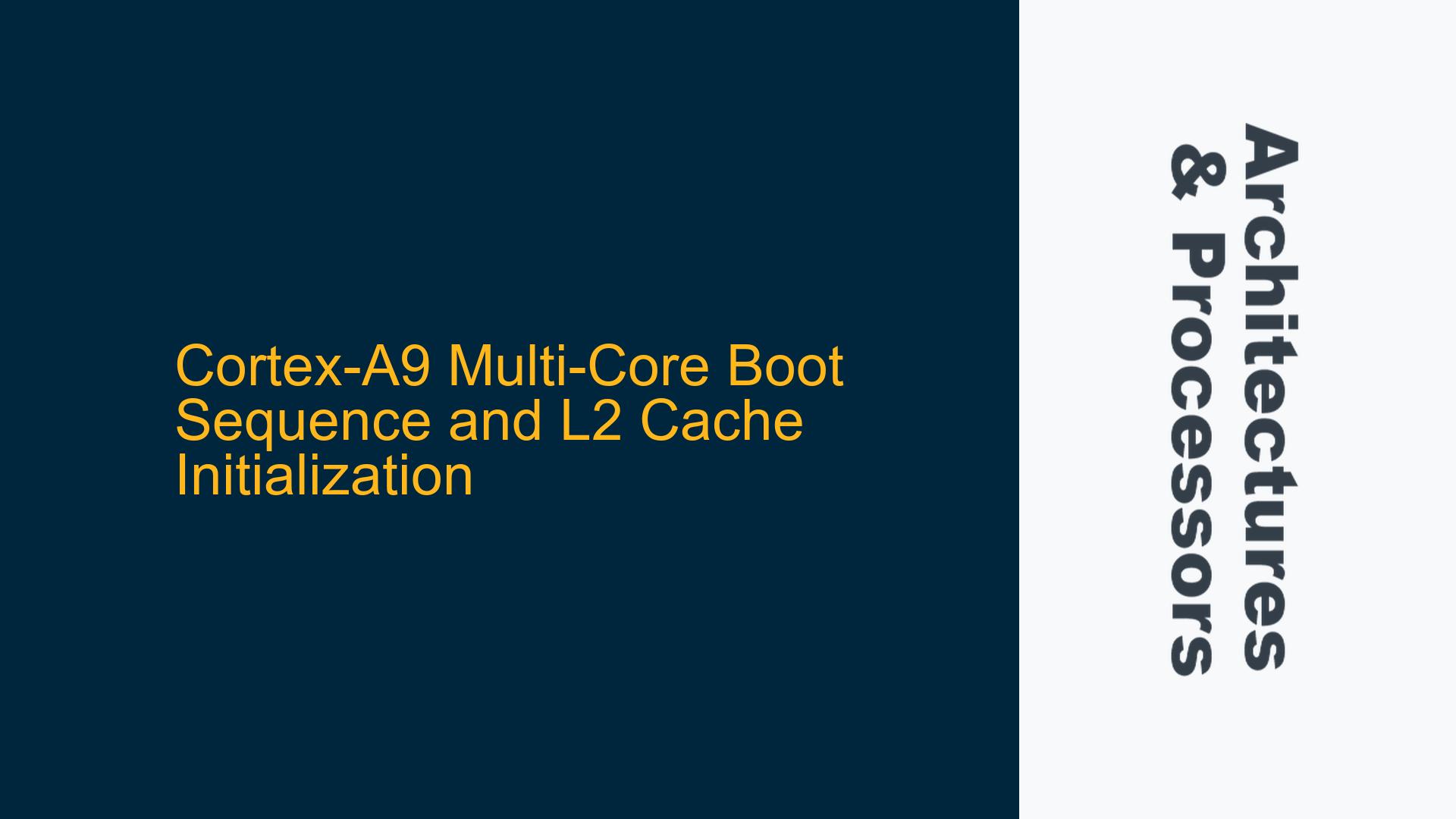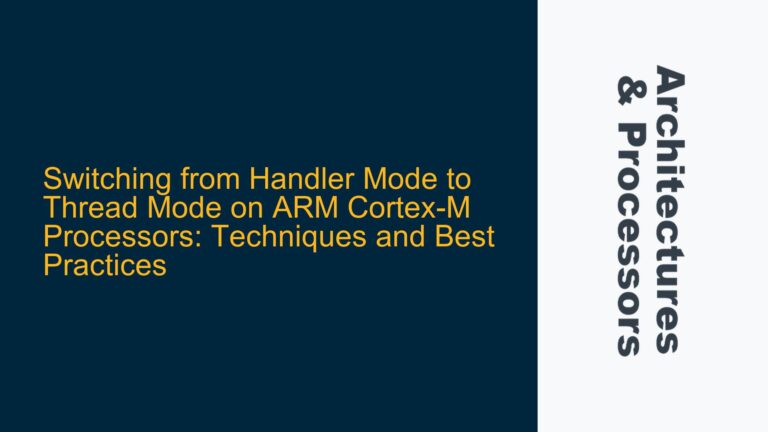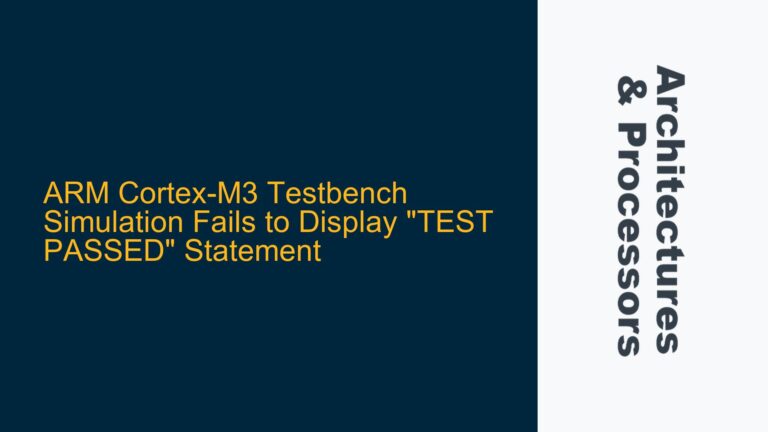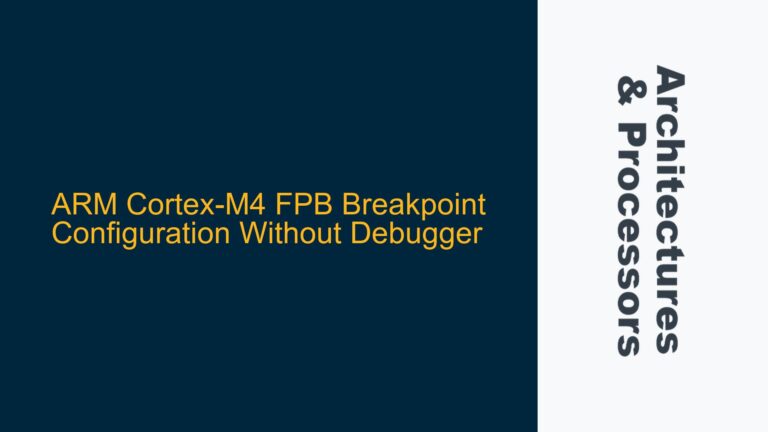Cortex-A9 Multi-Core Boot Sequence and Cache Coherency Challenges
The Cortex-A9 processor, particularly in its multi-core (MP) configuration, presents unique challenges during the boot sequence, especially when dealing with cache initialization and coherency across multiple cores. The primary concern revolves around the timing and sequence of enabling the L2 cache (L2C-310) in a multi-core environment. The Cortex-A9 relies heavily on cache coherency to ensure that all cores have a consistent view of memory, and improper initialization can lead to subtle bugs, data corruption, or system crashes.
The boot sequence for the primary core (Core 0) involves a series of steps to initialize memory, caches, and the Memory Management Unit (MMU). These steps include disabling and invalidating caches, setting up the MMU tables, enabling the System Control Unit (SCU), and finally enabling the caches and MMU. However, the initialization of secondary cores (Core 1, Core 2, etc.) introduces additional complexity, particularly regarding the L2 cache. The L2 cache is shared among all cores, and its state must be carefully managed to ensure coherency.
The core issue here is determining the correct point at which the L2 cache can be safely enabled. Should the L2 cache be enabled before or after the secondary cores are brought online? Enabling the L2 cache too early can result in coherency issues if the secondary cores are not yet ready to participate in the coherency protocol. Conversely, enabling the L2 cache too late can lead to performance degradation, as the secondary cores will be operating without the benefits of the shared L2 cache.
L2 Cache Initialization Timing and Multi-Core Coherency
The timing of L2 cache initialization in a multi-core Cortex-A9 system is critical to ensuring proper cache coherency and system stability. The L2 cache, being shared among all cores, must be initialized in a way that guarantees all cores have a consistent view of memory. This involves careful consideration of the state of each core, the state of the L2 cache, and the interactions between them.
One of the primary concerns is the state of the L2 cache when secondary cores are brought online. If the L2 cache is enabled before the secondary cores are initialized, there is a risk that the secondary cores will not be able to participate in the cache coherency protocol correctly. This can lead to situations where one core has a stale view of memory, leading to data corruption or incorrect program behavior.
Another consideration is the state of the L1 caches in the secondary cores. The L1 caches in each core must be invalidated and disabled before the L2 cache is enabled. This ensures that when the L2 cache is enabled, all cores start with a clean slate and can participate in the coherency protocol correctly. Failure to do so can result in coherency issues, as the L1 caches may contain stale data that is not consistent with the L2 cache.
The System Control Unit (SCU) plays a crucial role in managing cache coherency in the Cortex-A9. The SCU is responsible for maintaining coherency between the L1 caches of the different cores and the shared L2 cache. The SCU must be enabled before the L2 cache is enabled, as it is responsible for ensuring that all cores have a consistent view of memory. Enabling the SCU too late can result in coherency issues, as the cores may not be able to communicate correctly with the L2 cache.
Implementing a Safe Multi-Core Boot Sequence with L2 Cache Initialization
To ensure a safe and correct multi-core boot sequence in a Cortex-A9 system, the following steps should be taken to initialize the L2 cache and bring the secondary cores online:
-
Primary Core Initialization: The primary core (Core 0) should be initialized first, following the standard boot sequence. This includes initializing memory and stacks, setting up the GICD and GICC, disabling and invalidating the L1 and L2 caches, setting up the MMU tables, and enabling the SCU. The primary core should then enable the L1 and L2 caches and the MMU.
-
Secondary Core Initialization: Before bringing the secondary cores online, the L1 caches in each core should be invalidated and disabled. This ensures that when the L2 cache is enabled, all cores start with a clean slate and can participate in the coherency protocol correctly. The secondary cores should then be brought online, with the SMP bit set in each core to ensure they participate in the coherency protocol.
-
L2 Cache Initialization: The L2 cache should be enabled only after the secondary cores have been initialized and their L1 caches have been invalidated and disabled. This ensures that all cores are ready to participate in the coherency protocol and that the L2 cache is in a consistent state. Once the L2 cache is enabled, the secondary cores can begin executing code and taking advantage of the shared L2 cache.
-
Cache Coherency Maintenance: After the L2 cache is enabled, it is important to ensure that cache coherency is maintained throughout the operation of the system. This includes using appropriate memory barriers (DSB, ISB) to ensure that all cores have a consistent view of memory, and regularly invalidating and cleaning the caches as needed to prevent stale data from causing coherency issues.
-
Testing and Validation: The boot sequence should be thoroughly tested and validated to ensure that all cores are operating correctly and that cache coherency is maintained. This includes testing with different workloads and scenarios to ensure that the system is robust and can handle a variety of conditions without encountering coherency issues.
By following these steps, you can ensure a safe and correct multi-core boot sequence in a Cortex-A9 system, with proper initialization of the L2 cache and maintenance of cache coherency. This will help to avoid subtle bugs, data corruption, and system crashes, and ensure that your system operates reliably and efficiently.
Detailed Explanation of Each Step
Primary Core Initialization
The primary core (Core 0) must be initialized first, as it is responsible for setting up the system and preparing it for the secondary cores. The initialization sequence for the primary core includes the following steps:
-
Memory and Stack Initialization: The primary core must initialize the memory and stacks that will be used by the system. This includes setting up the stack pointers and allocating memory for the operating system and application code.
-
GICD and GICC Initialization: The Generic Interrupt Controller Distributor (GICD) and Generic Interrupt Controller CPU Interface (GICC) must be initialized to handle interrupts in the system. This includes configuring the interrupt priorities and enabling the interrupt controller.
-
Cache Initialization: The L1 and L2 caches must be disabled and invalidated to ensure that they are in a known state before the MMU is enabled. This includes invalidating the L1 data cache, invalidating the L1 instruction cache, and invalidating the TLB.
-
MMU Initialization: The Memory Management Unit (MMU) must be initialized to provide virtual memory support. This includes allocating memory for the MMU tables, writing the address of the MMU table into TTBR0, and creating the basic entries in the MMU table.
-
SCU Initialization: The System Control Unit (SCU) must be enabled to manage cache coherency between the cores. This includes setting the SMP bit and enabling the SCU.
-
Cache and MMU Enablement: Once the MMU and SCU are initialized, the L1 and L2 caches can be enabled, followed by the MMU. This includes enabling the data cache prefetch, enabling branch prediction, and enabling the instruction cache.
Secondary Core Initialization
The secondary cores must be initialized after the primary core has completed its initialization sequence. The initialization sequence for the secondary cores includes the following steps:
-
L1 Cache Invalidation and Disablement: Before the secondary cores are brought online, their L1 caches must be invalidated and disabled. This ensures that when the L2 cache is enabled, all cores start with a clean slate and can participate in the coherency protocol correctly.
-
Core Bring-Up: The secondary cores can then be brought online, with the SMP bit set in each core to ensure they participate in the coherency protocol. This includes setting up the stack pointers and initializing the core-specific registers.
L2 Cache Initialization
The L2 cache should be enabled only after the secondary cores have been initialized and their L1 caches have been invalidated and disabled. This ensures that all cores are ready to participate in the coherency protocol and that the L2 cache is in a consistent state. The L2 cache initialization sequence includes the following steps:
-
L2 Cache Enablement: The L2 cache can be enabled once the secondary cores are ready. This includes enabling the L2 cache controller and configuring the cache settings.
-
Cache Coherency Maintenance: After the L2 cache is enabled, it is important to ensure that cache coherency is maintained throughout the operation of the system. This includes using appropriate memory barriers (DSB, ISB) to ensure that all cores have a consistent view of memory, and regularly invalidating and cleaning the caches as needed to prevent stale data from causing coherency issues.
Testing and Validation
The boot sequence should be thoroughly tested and validated to ensure that all cores are operating correctly and that cache coherency is maintained. This includes testing with different workloads and scenarios to ensure that the system is robust and can handle a variety of conditions without encountering coherency issues. The testing and validation process includes the following steps:
-
Functional Testing: The system should be tested with a variety of workloads to ensure that all cores are operating correctly and that the system is functioning as expected.
-
Cache Coherency Testing: The system should be tested to ensure that cache coherency is maintained under different conditions. This includes testing with different memory access patterns and ensuring that all cores have a consistent view of memory.
-
Stress Testing: The system should be stress-tested to ensure that it can handle high loads and extreme conditions without encountering coherency issues or system crashes.
By following these steps, you can ensure a safe and correct multi-core boot sequence in a Cortex-A9 system, with proper initialization of the L2 cache and maintenance of cache coherency. This will help to avoid subtle bugs, data corruption, and system crashes, and ensure that your system operates reliably and efficiently.






